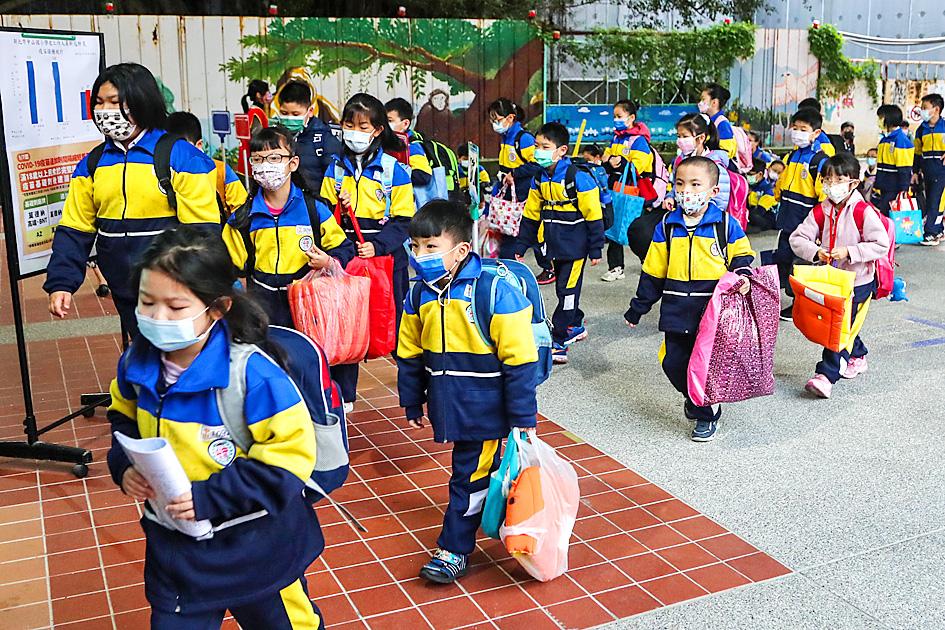The nation’s student population dropped to a new low of 4.17 million in the 2021 school year, 41,000 fewer than the previous school year, while the number of elementary schools with fewer than 100 students has reached a record 1,191, the latest Ministry of Education data showed.
The latest figure represented a drop of 332,000 students from the 2016 school year, the data showed.
Elementary-school students made up the largest group with 1.19 million, followed by vocational high-school students with 1.18 million.

Photo: CNA
Preschoolers, and junior-high school and high-school students accounted for a total of 1.74 million, the data showed.
The nation’s student population fell 1 percent from the previous school year. High schools and vocational high schools lost 24,000 students, a decline of 4 percent, over the period, the ministry data showed.
The number of college students decreased by 18,000, while the number of junior-high school students fell by 11,000 and that of preschoolers dropped by 1,000 from the previous school year, the data showed.
Compared with the 2016 school year, the number of elementary-school students fell by 32,000, or 7.4 percent, while the number of children enrolled in kindergartens rose by 89,000 over the past five years.
The number of schools — ranging from elementary to high-school level — with fewer than 100 students rose to 1,191, increasing by eight from the 2020 school year and rising by 152 from the 2016 school year.
Kindergartens are the most numerous kind of educational institution in the nation with 6,507 establishments, accounting for 42 percent of all educational institutions.
The number of kindergartens has been increasing at a rate of 60 establishments per year, the data showed.
The growth was mainly fueled by the opening of new public preschools. The government opened 365 public preschools over the past five years, while 168 private kindergartens closed down.
One public and four private elementary schools, two public and one private junior-high school, one private high school, and three private colleges and junior colleges closed down, the data showed.
Deputy Minister of Education Tsai Ching-hua (蔡清華) said the ministry is reducing the teacher-to-student ratio across all grades, while the K-12 Education Administration has established a task force to assist high schools with low enrollment numbers.
To better protect the education rights of children living in rural areas, local governments should consider opening classes comprising students of different ages at schools before merging or closing them, he said.
The ministry is adamant in its stance that schools must begin classes even if they have only one student.
The number of teachers across all school levels this school year is 31,000, 9,000 fewer than in the 2016 school year, while the number of preschool teachers has risen by 11,000, or 23.4 percent, the data showed.
Compared with 2015, the number of junior-high school teachers have decreased by 2,000 to 46,000, high-school teachers fell by 4,000 to 51,000, and the number of teachers at junior colleges and colleges dropped by 3,000 to 45,000.

Nvidia Corp yesterday unveiled its new high-speed interconnect technology, NVLink Fusion, with Taiwanese application-specific IC (ASIC) designers Alchip Technologies Ltd (世芯) and MediaTek Inc (聯發科) among the first to adopt the technology to help build semi-custom artificial intelligence (AI) infrastructure for hyperscalers. Nvidia has opened its technology to outside users, as hyperscalers and cloud service providers are building their own cost-effective AI chips, or accelerators, used in AI servers by leveraging ASIC firms’ designing capabilities to reduce their dependence on Nvidia. Previously, NVLink technology was only available for Nvidia’s own AI platform. “NVLink Fusion opens Nvidia’s AI platform and rich ecosystem for

‘WORLD’S LOSS’: Taiwan’s exclusion robs the world of the benefits it could get from one of the foremost practitioners of disease prevention and public health, Minister Chiu said Taiwan should be allowed to join the World Health Assembly (WHA) as an irreplaceable contributor to global health and disease prevention efforts, Minister of Foreign Affairs Lin Chia-lung (林佳龍) said yesterday. He made the comment at a news conference in Taipei, hours before a Taiwanese delegation was to depart for Geneva, Switzerland, seeking to meet with foreign representatives for a bilateral meeting on the sidelines of the WHA, the WHO’s annual decisionmaking meeting, which would be held from Monday next week to May 27. As of yesterday, Taiwan had yet to receive an invitation. Taiwan has much to offer to the international community’s

CAUSE AND EFFECT: China’s policies prompted the US to increase its presence in the Indo-Pacific, and Beijing should consider if this outcome is in its best interests, Lai said China has been escalating its military and political pressure on Taiwan for many years, but should reflect on this strategy and think about what is really in its best interest, President William Lai (賴清德) said. Lai made the remark in a YouTube interview with Mindi World News that was broadcast on Saturday, ahead of the first anniversary of his presidential inauguration tomorrow. The US has clearly stated that China is its biggest challenge and threat, with US President Donald Trump and US Secretary of Defense Pete Hegseth repeatedly saying that the US should increase its forces in the Indo-Pacific region

ALL TOGETHER: Only by including Taiwan can the WHA fully exemplify its commitment to ‘One World for Health,’ the representative offices of eight nations in Taiwan said The representative offices in Taiwan of eight nations yesterday issued a joint statement reiterating their support for Taiwan’s meaningful engagement with the WHO and for Taipei’s participation as an observer at the World Health Assembly (WHA). The joint statement came as Taiwan has not received an invitation to this year’s WHA, which started yesterday and runs until Tuesday next week. This year’s meeting of the decisionmaking body of the WHO in Geneva, Switzerland, would be the ninth consecutive year Taiwan has been excluded. The eight offices, which reaffirmed their support for Taiwan, are the British Office Taipei, the Australian Office Taipei, the